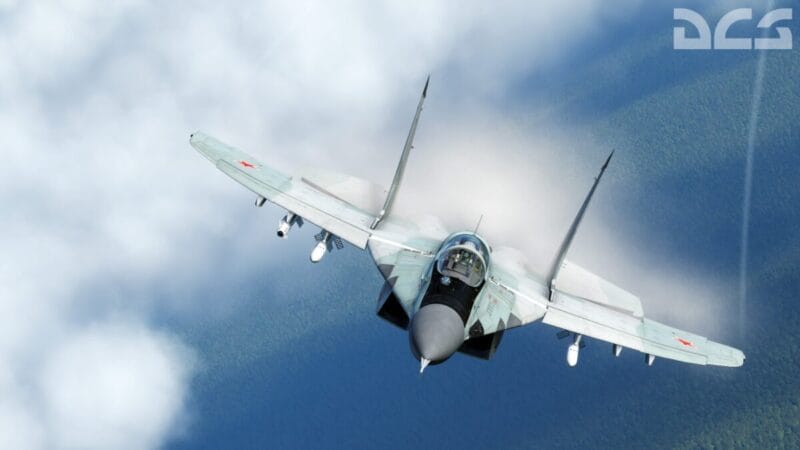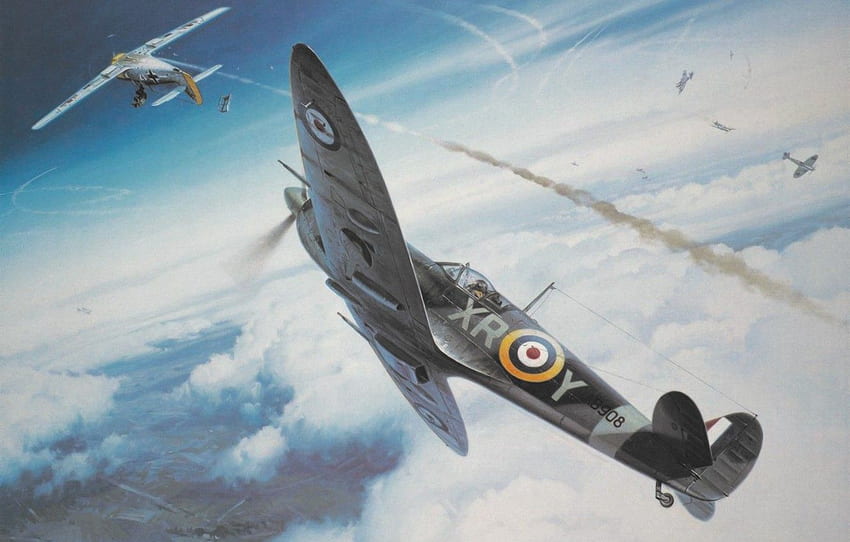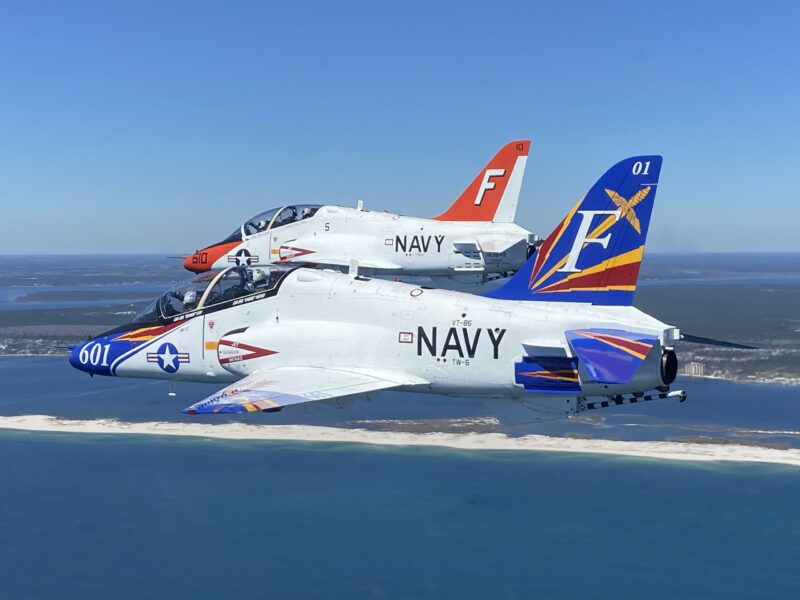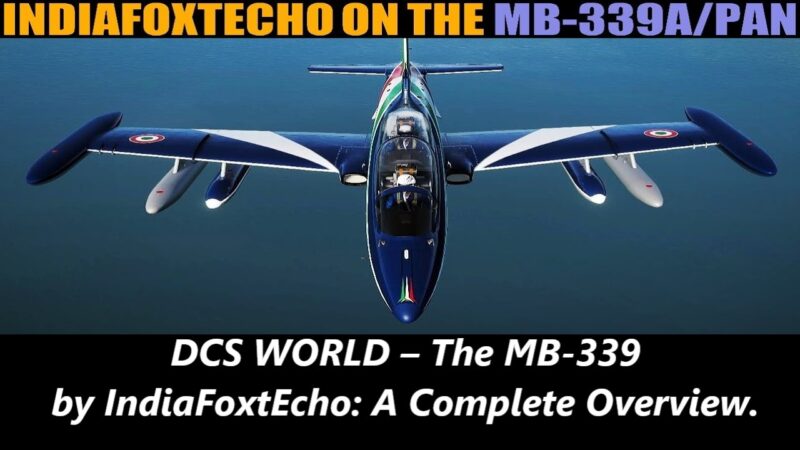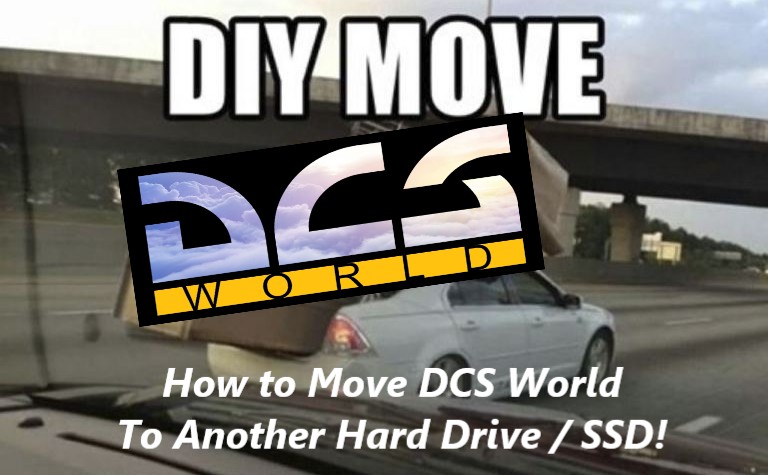The Best Graphics Cards Right Now (2025) – A Buyer’s Guide by Performance Tiers.
In 2025, the GPU market is dominated by NVIDIA’s RTX 50-series (Blackwell), AMD’s latest high-end and midrange releases (7000 family plus newer 9000/8000 refreshes), and Intel’s growing Arc B-series for budget-conscious gamers.
This guide is aimed at flight-sim enthusiasts and serious PC gamers, with a focus on performance in Microsoft Flight Simulator (MSFS), X-Plane 12, and DCS World.
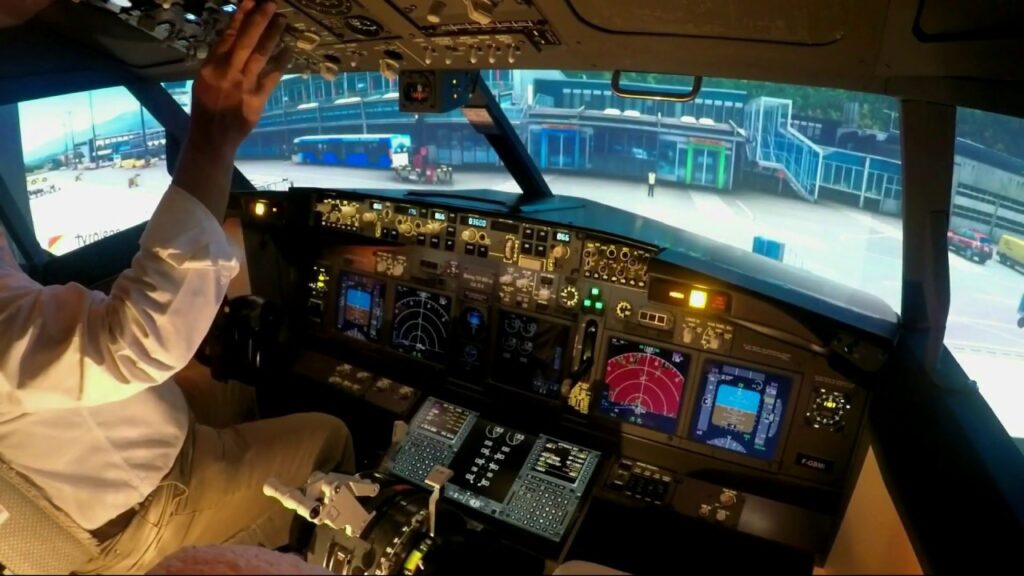
We’ll group the cards into performance “classes” (5050 → 5090) and include AMD and Intel competitors alongside NVIDIA. You’ll also get guidance on price-to-performance, cost-per-frame, and the reality of a fast-moving GPU market.
Understanding Rasterization vs Frame Generation.
Before diving into numbers, it’s important to understand the difference between rasterization and frame generation, because raw FPS figures don’t tell the whole story.
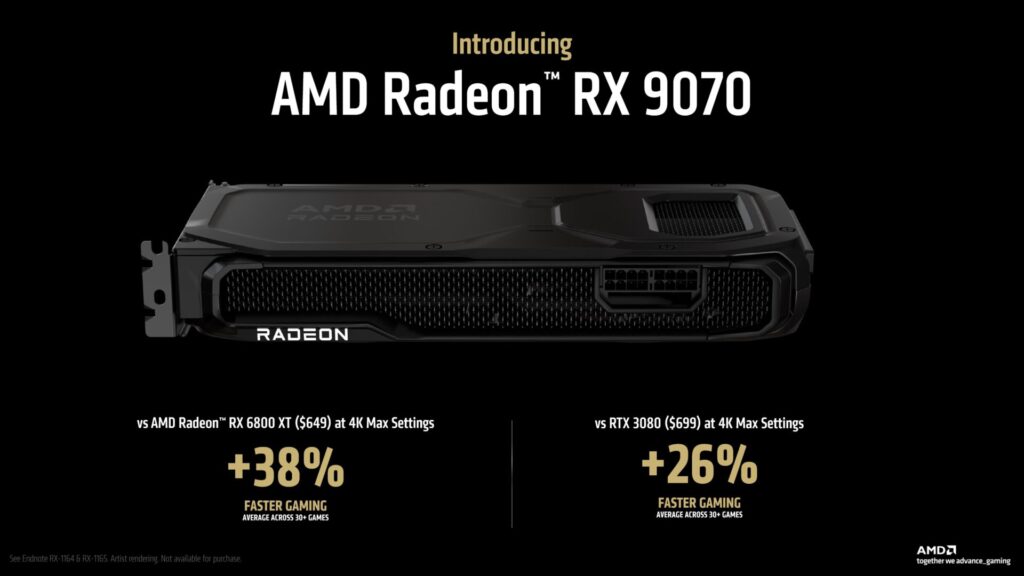
Rasterization Explained/
This is the traditional method of rendering graphics. Every pixel’s colour, lighting, and shading is calculated directly by the GPU’s hardware. Performance figures by companies like NVIDIA often claim exceptional FPS but don’t always make it clear its an AI multi frame generation process and not raw performance.
Raw rasterization performance is an important component depending on your flight simulator or game you wish to play. X Plane does not have multi Frame Generation (MFG) so its not an important metric when considering your nest GPU. On the other hand MSFS as well as DCS World both have DLSS 4.0 but not MFG at the time of writing.
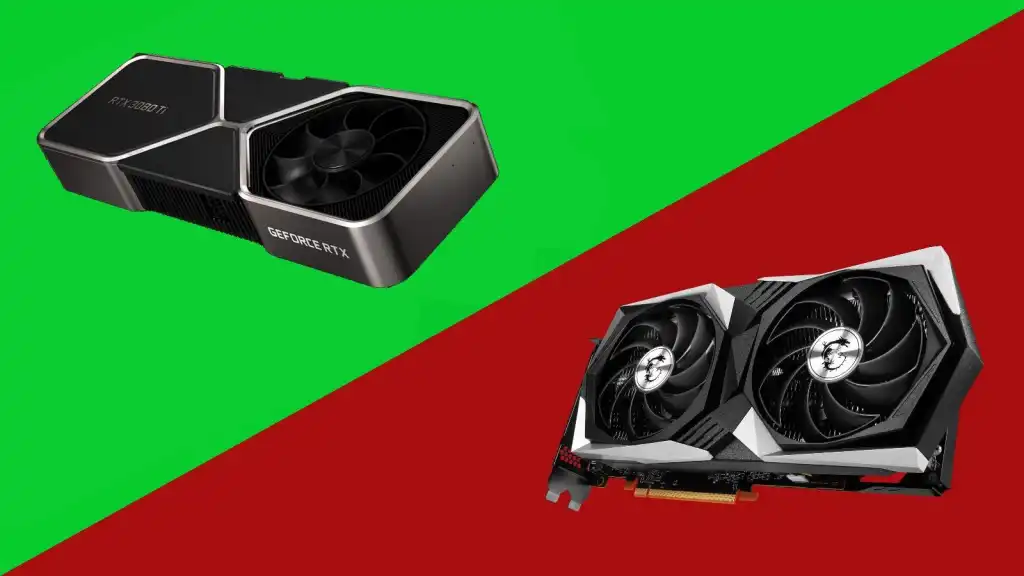
Know Your GPU Features – DLSS/FSR/XeSS/MFG
Knowing your focus and the features it supports is so important so as not to make the wrong purchase only to find a feature you based your performance on is not available!
- X Plane 12 – FSR (Old Version Only) – No DLSS – NO MFG
- MSFS 2020/2024 – DLSS 4.0 – FSR 2.0 (Update to 3 to come) – NO MFG
- DCS World – DLSS 4.0 – FSR – (No XeSS) – NO MFG
Games that offer Nvidia DLSS & MFG can be found on the NVIDIA Website HERE.
Games that support AMD – FSR 4 Features – AMD Website Here.
Games that support INTEL XeSS (Xe Super Sampling) – VideoCARDZ.com
- Pros: Works in all games, predictable image quality, no added latency.
- Cons: Limited by your GPU’s raw processing power.

Frame Generation (AI-Assisted Frames)
Instead of rendering every frame, the GPU renders one frame and uses AI algorithms to generate an extra frame in between. What’s important is that Frame generation (One additional Frame) & MFG (multiple additional AI generated frames) are said to add some latency to game play.
The extent depends on the game or simulator for sure. I would expect latency in most simulators to be minimal with the production of rasterised frames often hard enough to start with so overall frame number isn’t massive. If your in a high FPS car simulator or a FPS with massive fps then MFG may be a factor in latency especially if your playing competitive sims.
- NVIDIA DLSS 3/4: Supported in MSFS and DCS World, uses motion vectors and AI to boost FPS.
- AMD FSR: AMD’s version; X-Plane 12 supports an older FSR version without modern frame-gen features.
- Intel XeSS: Intel’s AI upscaler and frame generator, supported in fewer titles.
Key point: Frame generation can dramatically improve FPS but may add input latency. It only works in supported games for example:
- MSFS: DLSS frame generation supported.
- X-Plane 12: Only older FSR (no modern frame-gen).
- DCS World: DLSS frame generation supported.
Quick Overview of GPU Families
NVIDIA — GeForce RTX 50-series (Blackwell)
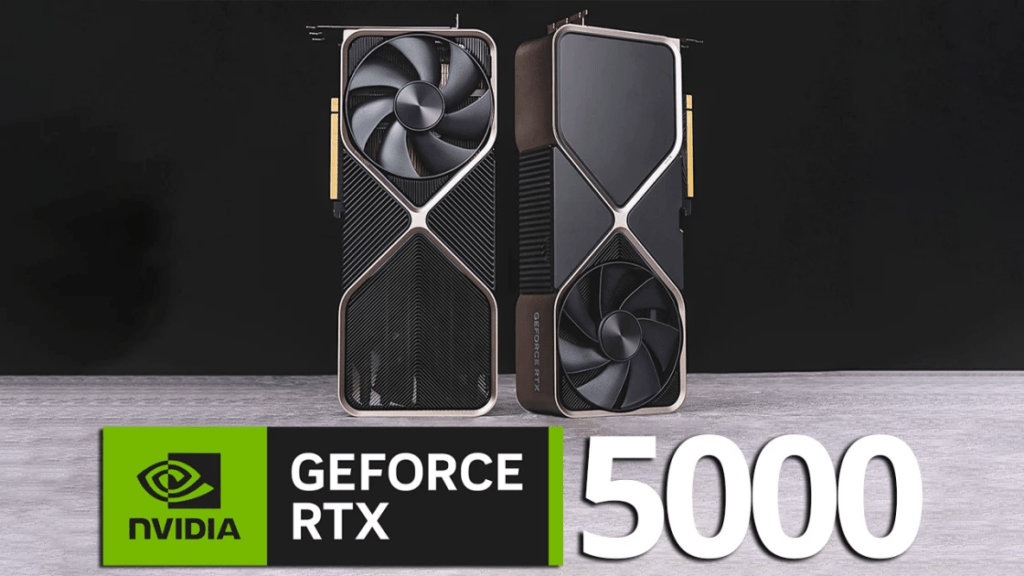
- Models: 5050, 5060/Ti, 5070/Ti, 5080, 5090.
- DLSS 4 + Multi Frame Generation for big FPS boosts in supported games.
- Example MSRPs: 5080 at ~$999, 5090 at ~$1,999.
Its alsi important to note that NVIDIA are planning to release MFG to the RTX 4000 series as a driver based feature in the near future according to reports. Nvidia have it working and expect to finalise it when Beta Testing is complete.
There is also an expectation of frame generation coming to the RTX 3000 series as well as a driver based feature but this is a ways off. The initial report of this LetsFLyVFR posted in January of 2025. Its taken about seven months to get the RTX 4000 series version ready, so please be patient RTX 3000 owners. READ MORE HERE!
AMD — Radeon (7000 family and newer models)
- Examples: RX 9070 XT, RX 7900 XTX.
- Strength: Better native rasterization performance per dollar compared to NVIDIA.
- Weakness: Ray tracing slower than NVIDIA, frame generation support still expanding.
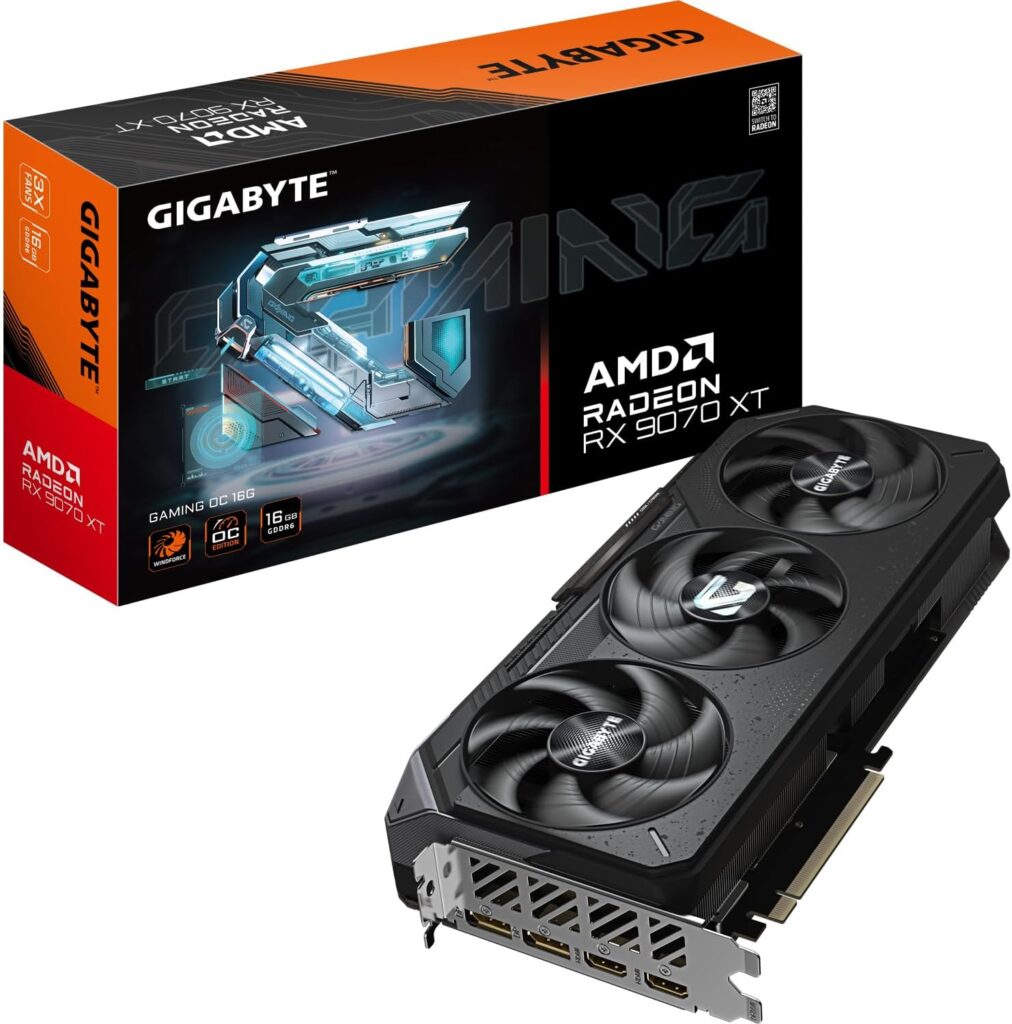
The latest series of 9000 GPU’s has been a breath of fresh air with the latest GPU releases fiercely fighting NVIDIA for market share. Generally better rasterization performance than NVIDIA GPU’s which like to talk about FG/MFG performance a lot more than raw performance.
The upscaling technology in FSR has improved dramatically and now is a very close competitor to the NVIDIA DLSS which is great. Performance, great price and excellent features.
Intel — Arc B-series (Battlemage)
- Example: Arc B580 (~$249 MSRP).
- Strength: Affordable entry to 1080p and 1440p gaming, drivers improving steadily.
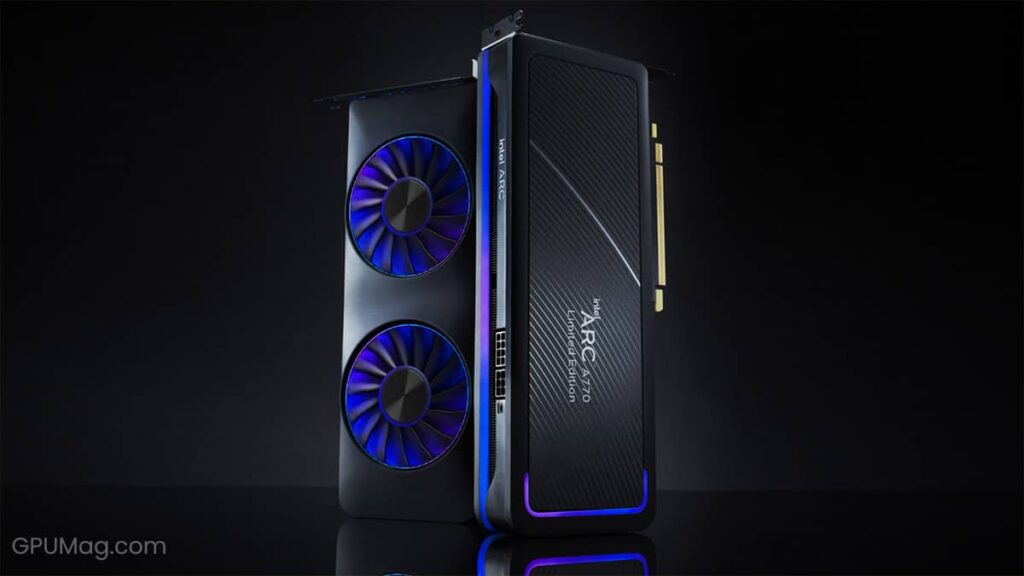
Intel are quietly working in the background on making their products and upscaling technology into a serious competitor. They offer solid 1080P & 1440P GPU’s with the XeSS getting better as well. Still limited in the market but worth a consideration for price to performance at the budget end of the market.
GPU Classes by Performance Level
This is an opportunity to compare the current range of available GPUs on offer in Mid 2025. If your unsure of what compares to what card with the naming structures of the different manufacturers you will be a lot clearer with the information below.
| Class | NVIDIA Example | AMD Example | Intel Example |
|---|---|---|---|
| 5050 | RTX 5050 | RX 7500 XT | Arc B560 |
| 5060 | RTX 5060/Ti | RX 9060 XT | Arc B580 |
| 5070 | RTX 5070/Ti | RX 9070 XT | — |
| 5080 | RTX 5080 | RX 8900 XT | — |
| 5090 | RTX 5090 | — | — |
Flight Sim Performance Comparisons
The following performance figures are representative averages for 1440p High/Ultra settings.
They were compiled from published reviews and community benchmarks.

Microsoft Flight Simulator (1440p Ultra)

X-Plane 12 (1440p High)

DCS World (1440p High)

Synthetic Benchmark (TimeSpy-like score)
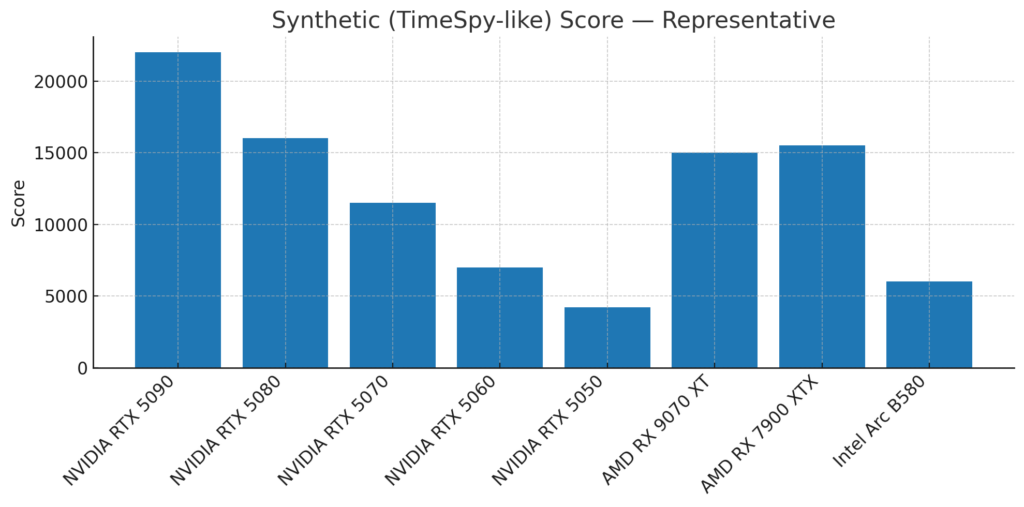
Download Synthetic Benchmark Chart
Price-to-Performance (Cost per Frame)
- Cost-per-frame = Price ÷ FPS in your main game.
- Check local retail prices – sales and shortages change things quickly.
- Match your GPU to your CPU – flight sims can be CPU bottlenecked.
CPU & GPU Bottleneck.
Its important to make sure you balance your CPU with your GPU to make the best performance possible. Resolution has a lot to say when your considering a purchase or either component.
Resolutions like 1080P are much more reliant on your CPU’s ability to produce frames generally controlling performance. Stepping up to 1440P/4K and maybe even 8K gaming then your GPU is going to be more the focus.
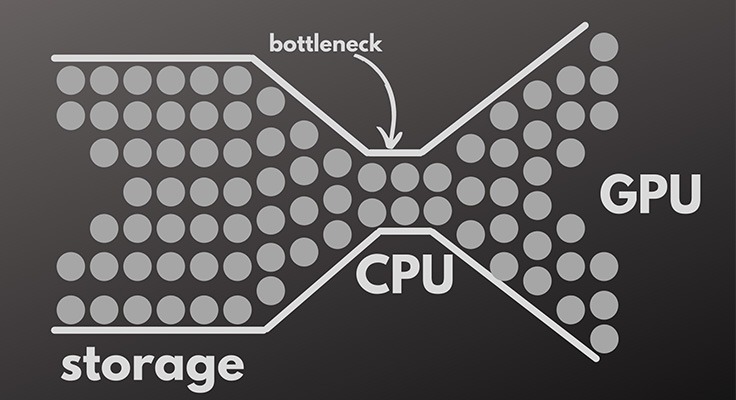
If your unsure there are some great CPU/GPU bottleneck calculators out there but its important when choosing one that you tell it exactly what your doing and what resolution your using.
Ensure you tell it your gaming or Graphic Intensive usage so it understands and gives you the correct result. Also tell it the resolution your using as I motioned above as this will change the result considerably.
Bottleneck Test Results
Here’s my own system being a AMD RYZEN 5600X With an NVIDIA RTX 3070 in both 1080P & 1440P. This system was never able to do 4K so I have not done testing there.
If your planning an upgrade or a new system a bottleneck calculator is a good start when planning how you spend the bulk of your money. There are many to choose from!
I’m using PCBUILDS Bottleneck Calculator Here.
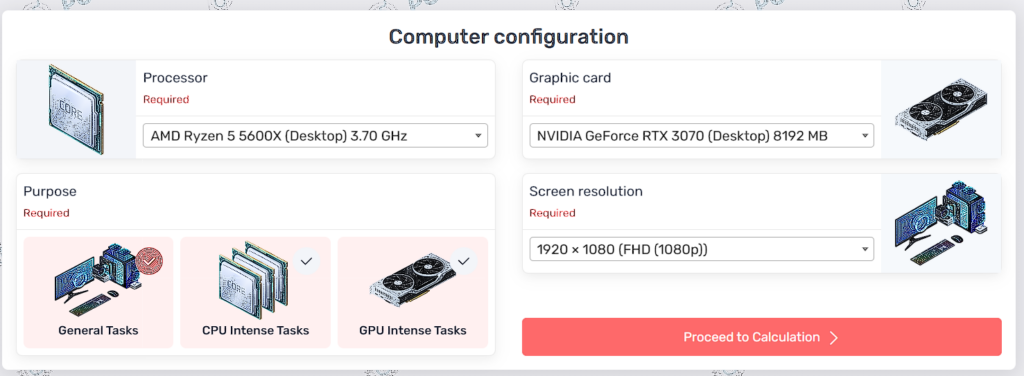
1080P General Tasks.
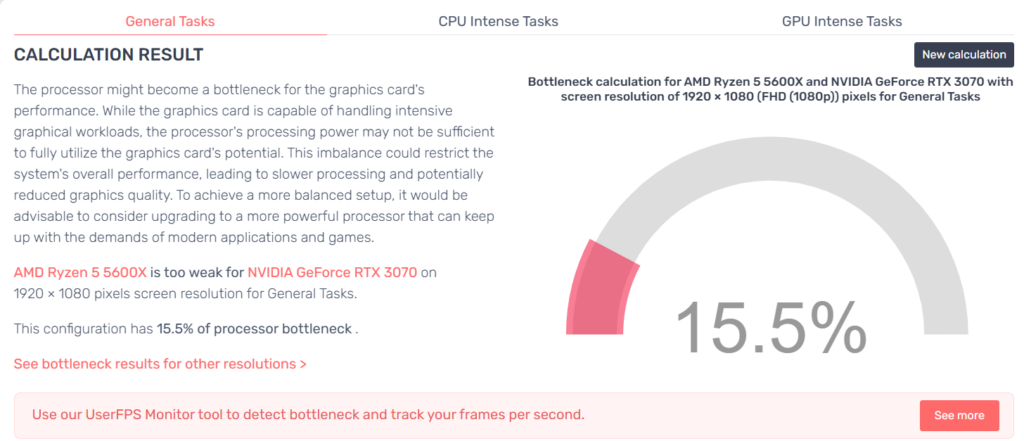
AMD Ryzen 5 5600X is too weak for NVIDIA GeForce RTX 3070 on 1920 × 1080 pixels screen resolution for General Tasks. This configuration has 15.5% of processor bottleneck .
1080P CPU Intensive Tasks.
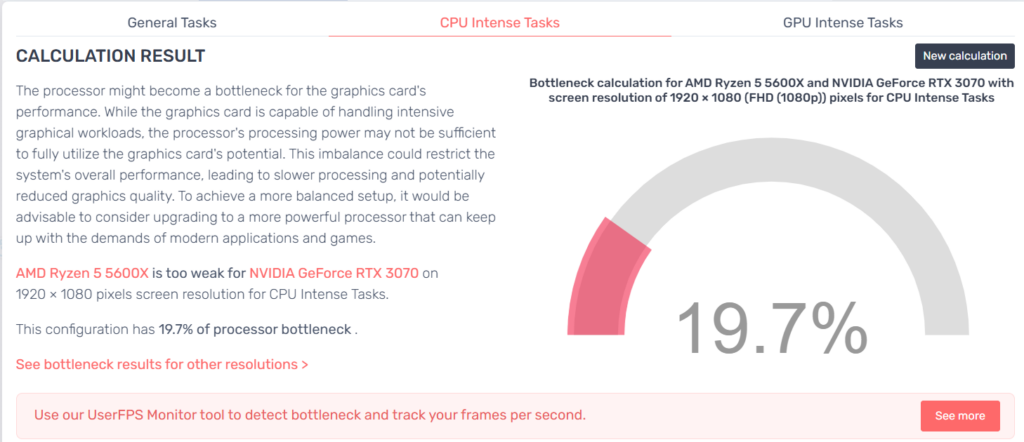
AMD Ryzen 5 5600X is too weak for NVIDIA GeForce RTX 3070 on 1920 × 1080 pixels screen resolution for CPU Intense Tasks. This configuration has 19.7% of processor bottleneck .
1080P GPU Intensive Tasks (ie Gaming).
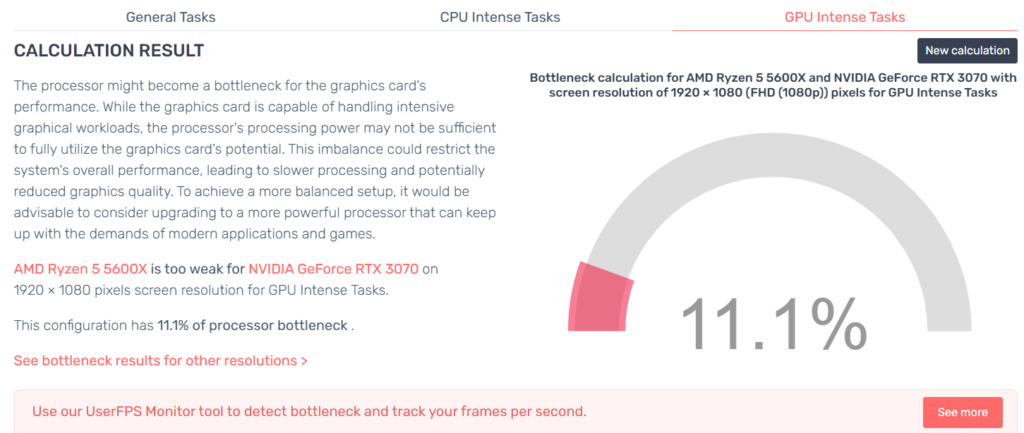
AMD Ryzen 5 5600X is too weak for NVIDIA GeForce RTX 3070 on 1920 × 1080 pixels screen resolution for GPU Intense Tasks. This configuration has 11.1% of processor bottleneck .
Bottleneck – 1440P
Looking at my 1080P results the CPU is stated at being to week and now at 1440 P the CPU is fine? What’s the reason behind this apiffany?
Honestly its simple: The GPU is doing more and more of the work so the CPU is no longer working as hard.
If you take this to 4K the whole system is not strong enough!
1440P (2K) GPU Intensive Tasks (Gaming).
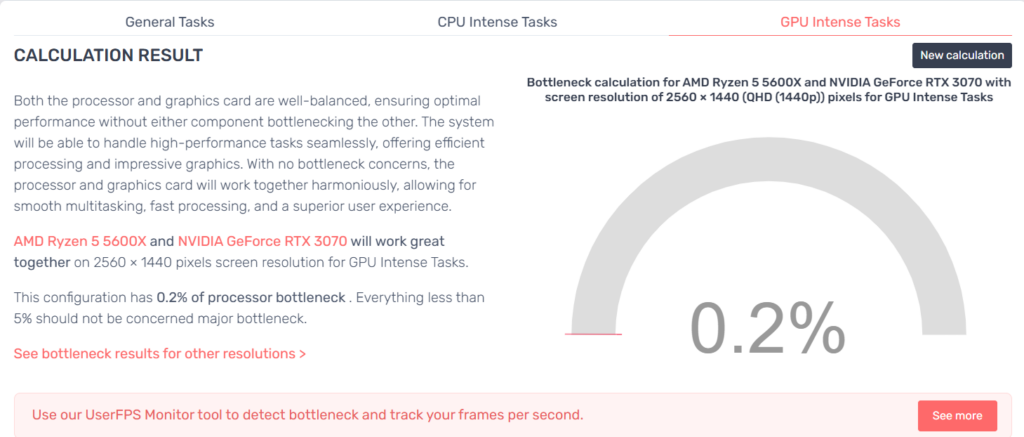
AMD Ryzen 5 5600X and NVIDIA GeForce RTX 3070 will work great together on 2560 × 1440 pixels screen resolution for GPU Intense Tasks.
This is a great result as my VR headset is essentially 1440P so its a great match.
Recommendations
- Best value for most: RTX 5070 / RTX 5080, or AMD RX 9070 XT / RX 7900 XTX.
- Maximum performance: RTX 5090 — if budget is not a concern.
- Budget-friendly: RTX 5060 or Intel Arc B580.
- Native rasterization value: AMD mid/high GPUs often lead in frames per dollar without upscaling.
The Complete Beginner’s Guide to DCS World
Welcome to the world of Digital Combat Simulator (DCS World), the ultimate flight combat simulation that brings the thrill of…
Comparing Real World Aviation Procedures to Flight Sim Techniques.
Flight simulators have grown into sophisticated training tools, bridging the gap between virtual flight and real-world aviation….
Mastering Dogfighting in DCS World and Falcon BMS: Max-Perform Your
This post covers essential techniques, cues, and parameters that new combat pilots need to dominate close-range dogfights in DCS World…

Full Guide: DCS Balkans Map + All Upcoming DCS World
Full Guide: DCS Balkans Map + All Upcoming DCS World Modules. Summary: Eagle Dynamics and OnReTech have officially announced DCS: Balkans,…
DCS World T-45 Goshawk Formation Flying for Beginners Tutorial .
Military Formation Flying in DCS: Your First Flight in the T-45 Goshawk. So, you’ve got your wings (virtually speaking), strapped into…
DCS WORLD T-45 Goshawk EASY Navigation for Beginners.
DCS WORLD T-45 Goshawk EASY Navigation for Beginners is simply that. We do our planning in the DCS World Editor…
How the U.S. Navy Trains Jet Pilots: A Complete T-45
Welcome to Letsflyvfr.com guide to T-45C Goshawk Training – How the U.S. Navy Trains Jet Pilots so you can train…
DCS WORLD – The MB-339 by IndiaFoxtEcho: A Complete Overview.
The MB-339 occupies a very particular niche in DCS World: it’s not a fighter, not a frontline attack jet, but…
How to Move DCS World to Another Drive – Tutorial.
Moving DCS World off your Windows drive is a great way to free up space especially with DCS now taking…
Final Notes:
The list of GPU’s remains great in number but as consumers we are still struggling with price to performance with a lot of the current offerings. Over and over from the big tech channels they are pointing out how AMD 9000 series GPU’s are the best value for money and really quite excellent on the raw rasterization performance.
It’s as always about the additional features you may wish to have like DLSS or FSR as well as the new video coding standards they offer. There is no clear winner so it’s about what you want. It again falls back to what you want in features like ray tracing and path tracings as well as DLSS and FSR all battle it out for our very valuable dollars.
I hope this guide can help your make up your mind with more confidence!
Author
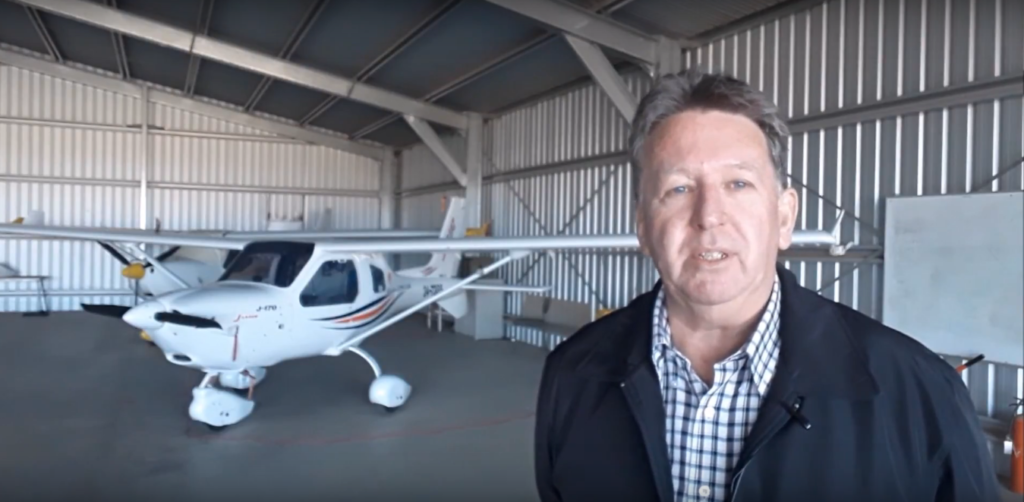
Brendon McAliece (Aka Gunnie) is a military veteran with 23 years working on Jet Fighters, their weapons systems and ejection seat/module systems as well as munitions and R&D. Involved with flight simulation since the 1980s, he has flown all the major flight simulators over the years.
He is an Australian expat who has lived in Malaysia, UK, Saudi Arabia and more recently Thailand. He is a multi-lingual blogger who loves to share his life experiences here on LetsFlyVFR.com and DreamingGuitar.com, with his lifestyle and Travel experiences Blog plus his Dreaming Coffee website.
Learn More @
DreamingGuitar.com – DreamingCoffee.com – LetsFlyVFR.com
(HOME – BLOG – SHOP – ABOUT)
This page has been viewed 0 times.
As an Amazon affiliate I may benefit from qualifying sales.

